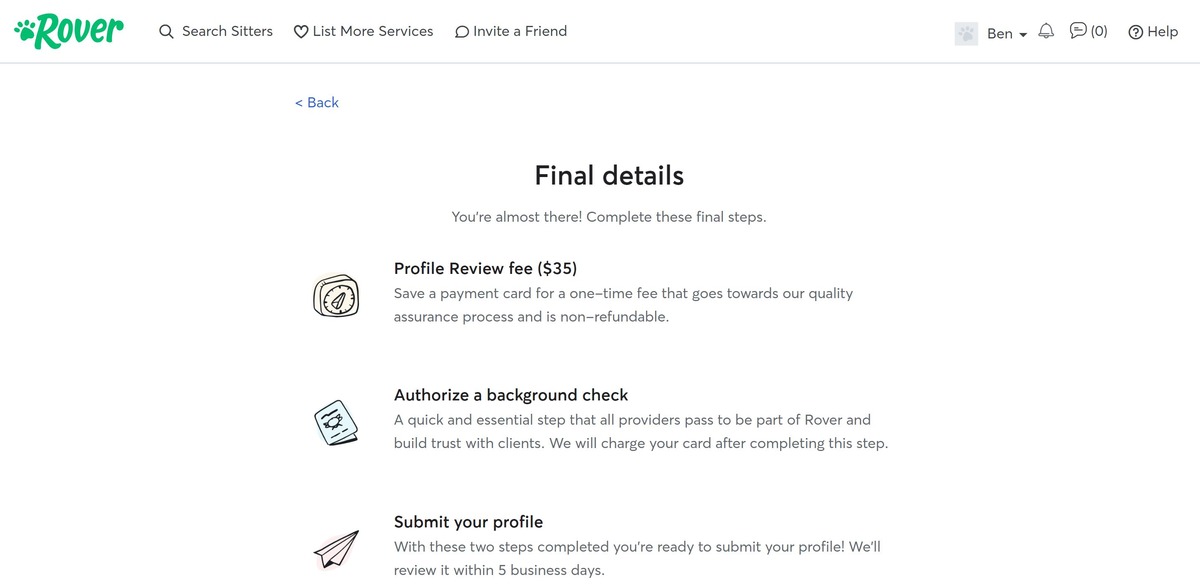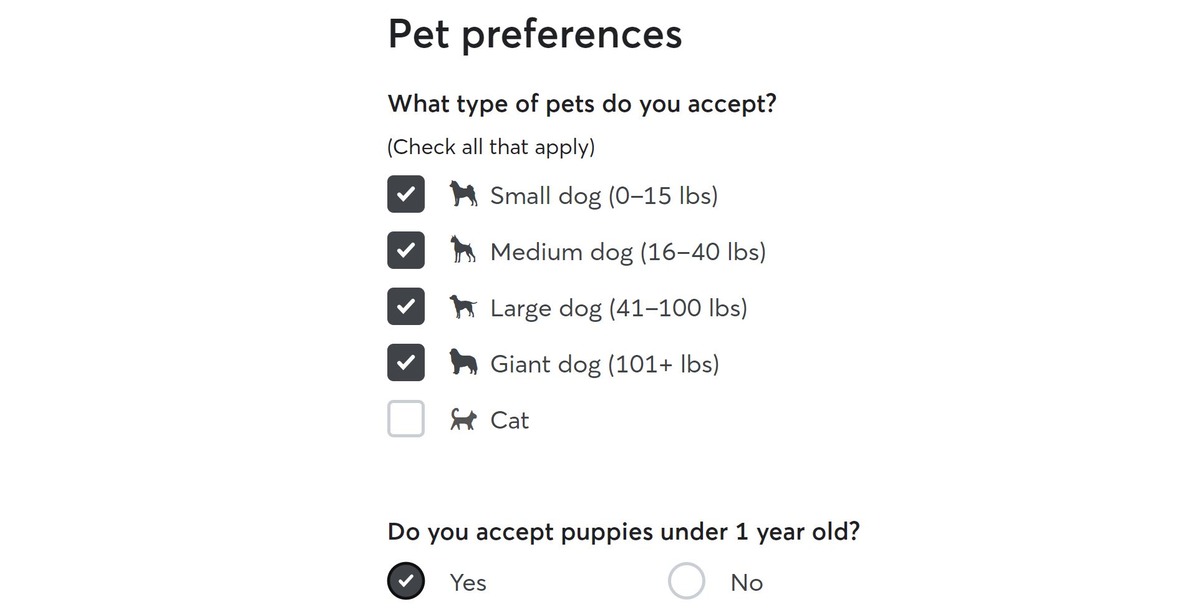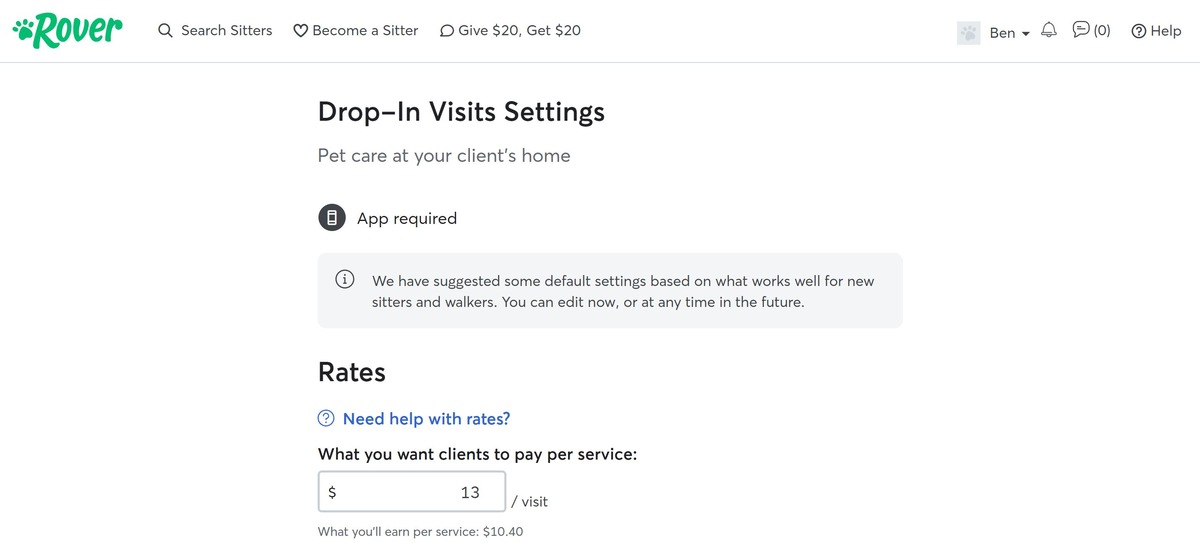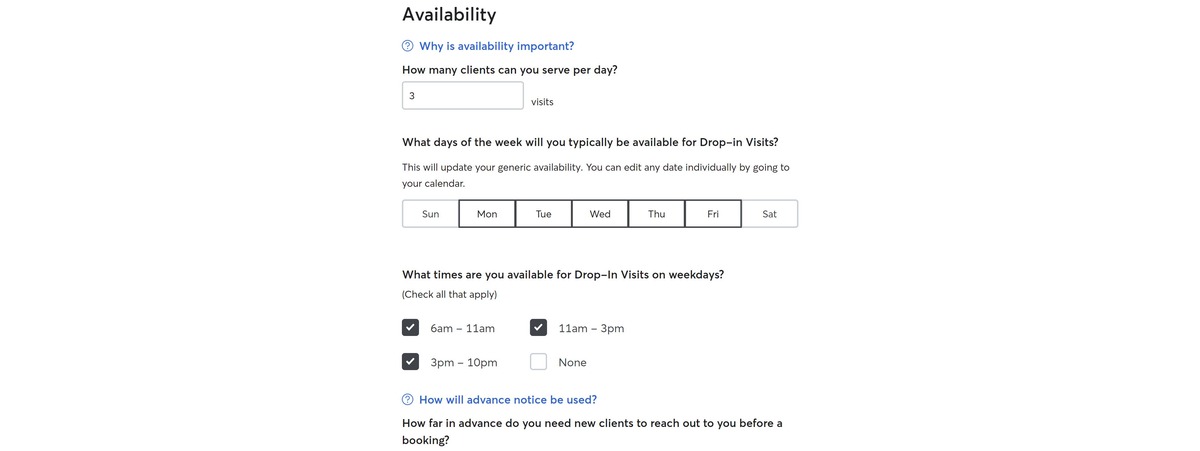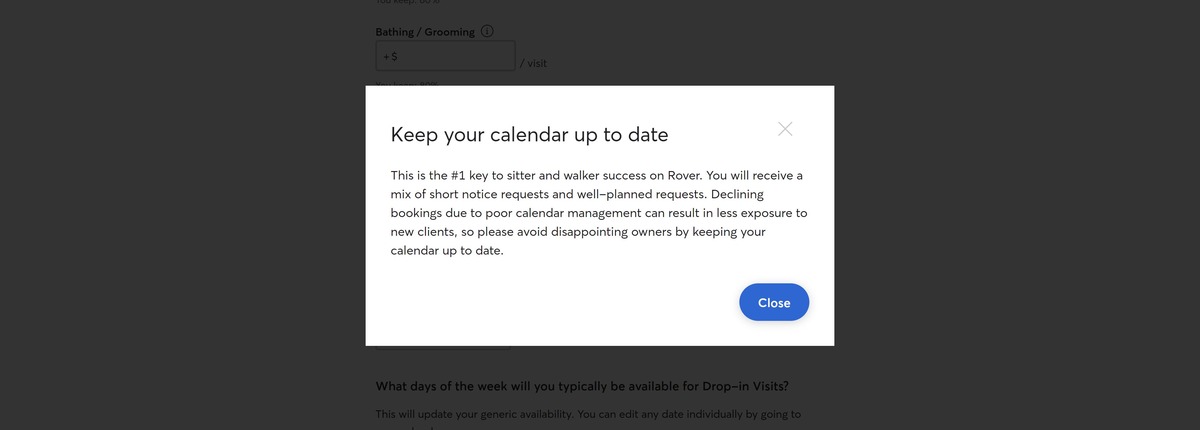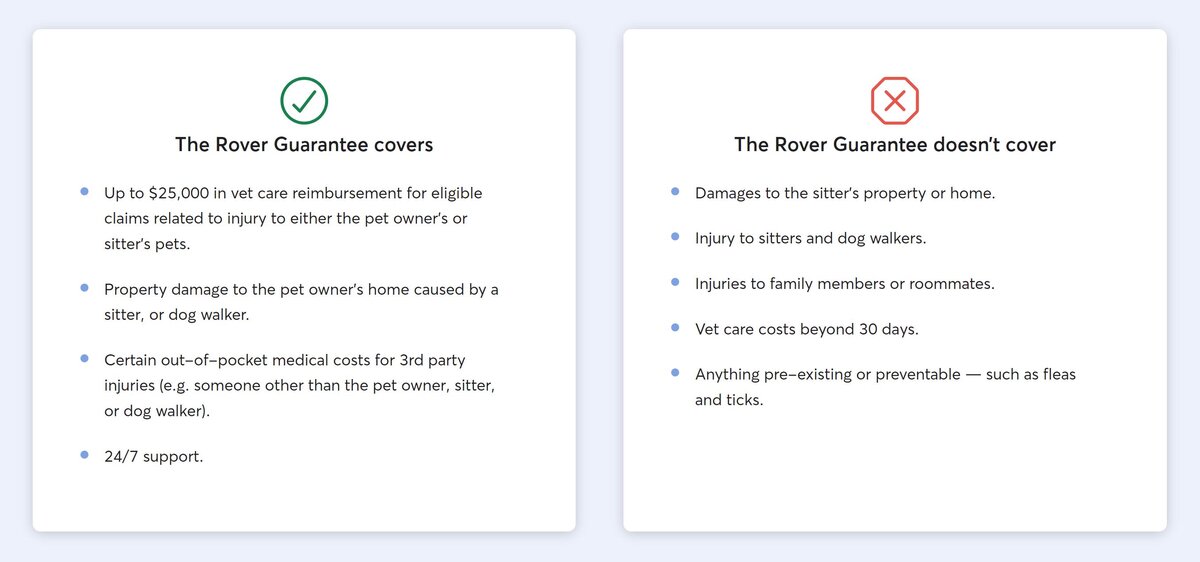Rover Review 2025: Is Dog Sitting a Worthwhile (or Safe) Gig?
Pet sitting can be an enjoyable way to combine your love of furry friends with the need to make a few extra bucks. Here's how to do exactly that using the Rover pet care marketplace.

Some of the links on DollarSprout point to products or services from partners we trust. If you choose to make a purchase through one, we may earn a commission, which supports the ongoing maintenance and improvement of our site at no additional cost to you. Learn more.
Launched in 2011, Rover has quickly become the world’s largest online marketplace for pet-sitting services.
From dog walking and daycare to boarding and house sitting, needy pet owners look to independent contractors to provide these essential services when there’s no room left at the inn for their furry friends.
But just because it’s the largest forum for providing pet care doesn’t necessarily mean it’s the best place to offer your services.
Sitter protections, pay, company-provided training, equipment, and insurance coverage are all factors you should take into consideration.
In our Rover sitter review, I examine the pros and cons of listing on the platform, what top (and bottom) percentile earners are making, share my best tips for advertising your services, and help you determine whether or not you’d be better off choosing a Rover.com alternative.
Pros
✔️ Can get started in just 5 to 10 days.
✔️ Flexible self-scheduling.
✔️ Can self-select services to provide (boarding, walking, etc.)
✔️ Set own rates.
✔️ Pause and resume service as desired.
✔️ A legitimate side hustle with scalable earnings ($100 to $1,000+ per month).
Cons
❌ $35 background check fee.
❌ Competition can be fierce.
❌ Rover fee of 20% per booking.
❌ Vehicle wear and tear can add up.
❌ High responsibility gig.
❌ Can be found liable for injury to person or property.
Best for: Side hustlers with pet care experience looking to make extra money.
Verdict: 4.0 out of 5 stars
- Earnings: 4.0 out of 5 stars
- Cost: 3.0 out of 5 stars
- Flexibility: 4.5 out of 5 stars
- Schedule: 4.5 out of 5 stars
Rover is a legit and easy-to-use marketplace for connecting pet owners with contractor sitters.
What Is Rover?
Rover.com connects pet owners with screened independent contractors who provide a variety of pet care-oriented services. To date, over 80 million services have been booked through the platform, making it the largest network of pet owners in the United States.
While there are, of course, pet care horror stories that scatter the internet, by and large, pet owners resoundingly appreciate the service provided.
“Sitters on Rover have received over 7.15 million reviews – 97% of which have a 5-star rating,” according to the company.[1] On a more independent note, Rover.com holds a 4.6-star (out of 5) rating on Trustpilot by pet owners who use the platform.[2]
For pet sitters interested in making money on Rover, the following services are currently offered on the platform:
Dog Services:
- Boarding
- House Sitting
- Drop-In Visits
- Doggy Day Care
- Dog Walking
Cat Services:
- Boarding
- House Sitting
- Drop-In Visits
When choosing which services to provide, sitters can set their own schedules, rates, size limitations, and whether they want to watch pets in their homes or those of the pets’. All payment is done through Rover, so the only thing to collect in person are the snuggles.
Getting started is easy, and prospective sitters can register, consent to [and pay for] a background check, and set up their profile in 20 minutes or less.
Rover.com, the world's largest marketplace for pet care, connects pet owners with independent contractors who provide services such as dog walking, daycare, and overnight house sitting. Sitters report robust earnings, schedule flexibility, and fulfillment as reasons to work with the company, but caution against getting in over your head in terms of services provided.
Show Hide moreHow to Become a Pet Sitter on Rover
Becoming a Rover sitter is a relatively painless process. Merely head to their Become a Sitter onboarding page to get started filling out your profile.
You’ll be asked to create an account using an email address or by linking one of your existing social profiles.
Rover Sitter applicants must provide:
- Photos of yourself, your home, and your yard (if you have one).
- Personal information including, name, address, and email address.
- Your social security number (they’ll need to issue a 1099-MISC if you earn more than $600).
- Bank account information so that they can pay you.
- A credit card for the $35 one-time background check fee.
Consent to Background Check
Rover solicits a third-party verification service — Sterling — to conduct a background check on Rover Sitter applicants. The cost is currently $35. (It has risen from $10 to $25 to its current $35, as there seems to be some confusion across the web.)
The background check validates that applicants are not on any sex offender registry or terrorist watchlist, and that they aren’t listed in the National Criminal Database for any disqualifying criminal offenses.
That said, Rover doesn’t seem to explicitly share which criminal offenses may disqualify an applicant. A perusal of their support community suggests things like DUIs, late child support, reckless driving, drug possession, and a seemingly random assortment of other charges have disqualifying potential (and existing) Rover sitters.
If you have something that you know is likely to be flagged on a background check, it may be worth passing on this opportunity and saving your $35.
Select Services to Offer
Continue by selecting the types of pets you’re willing and able to care for, and the exact services that you’re willing to provide.
I have no cats and know next to nothing about them, so choosing to care for one is out of my wheelhouse. With a big fenced-in backyard and experience with large breed dogs, I’m willing to care for just about anything with four legs and a wagging tail.
Next, you’ll select the specific pet care services you’re able to provide. Boarding and House Sitting are the top earning services, which comes as no surprise.
But if you’re schedule is free, and you don’t mind traveling a bit, Dog Walking and Drop-In Visits can be good earning activities, especially if you can build a list of clients in a small geographical area (reducing transit time, vehicle wear and tear, etc.).
🔍 Reviewer’s Note:
I cannot stress this enough. Do not select or attempt to provide pet care services for animals that you are not physically equipped or knowledgeable enough to provide care for.
It is unfair to you and the animal. Experience with breed size, pre-existing conditions, and the ability to recognize acute changes in a pet’s health are essential skills that will keep both you and the animal happy and safe. I had experience caring for a variety of health conditions and medicine administration prior to joining the Rover platform.
Rover advertises access to Sitter training services and 24/7 vet consulting, but they are not mandatory, and those resources only protect you if you actually use them.
Currently, I only offer doggy daycare and boarding services. This is a personal preference because it helps cut down on miscellaneous expenses. Traveling long distances for drop-ins and walks, especially with gas prices where they are, can deeply cut into earnings.
It can be difficult to drum up business in certain areas, especially when competing for visibility with dozens of more established Rover sitters. You can always temporarily offer these services to get your feet wet (and build review history) and then cut back on what you don’t enjoy or find isn’t worth your time.
Set Pricing
There are some tips we will get to shortly to start landing higher-paying clients (and charging based on merit), but if you’re just getting started out, a general good rule of thumb is to price your services in the bottom 25% percentile of available sitters.
The reality is that social proof is an important factor in pet owners choosing who they trust to care for their pets, especially if it’s their first time working with a certain Sitter. Rover very heavily leans into showing pet owners why they should trust available sitters. Front and center on every search is a Sitter’s background check badge, their historical ratings, the number of reviews, and a sampling of relevant testimonials.
If you have very little documented history on the platform, it may take some time to land those first few paying clients, even if you are extraordinarily qualified.
Users tend to gloss over meagerly put-together profiles that are bare or don’t scream high levels of trust, even if their rates are lower.
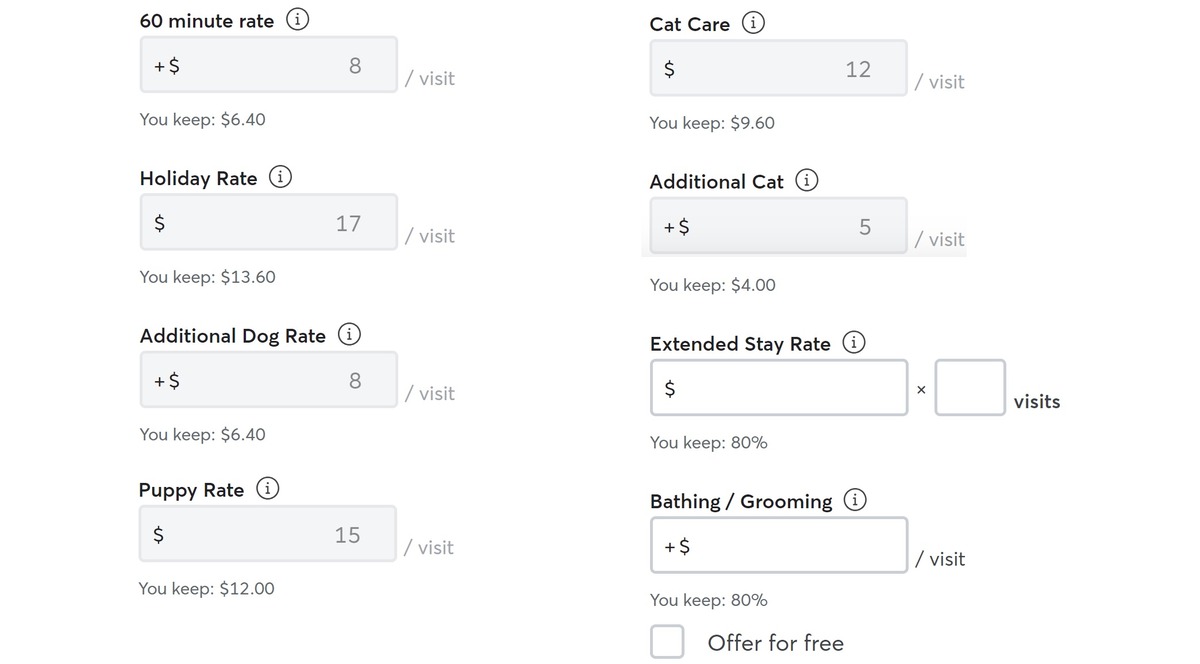
While you should never underprice your services, it is important to take into account what other sitters around you are charging. By charging in the bottom 25% percentile and very clearly enunciating your qualifications, it is likely you will find bookings, even in the most challenging of rural markets.
Once you have 10 reviews under your belt, consider price blending to more appropriately reflect your personal skills and the market around you. Highly reviewed sitters can easily charge in the top 10% of their market due to their established and documented history of high-quality pet care.
🔍 Rover on Pricing:
“We recommend searching your zip code to see what top sitters are charging. Set your rates $3 to $5 below what top sitters charge, and we suggest setting it to at least $30 for overnight services, at least $15 for walks and drop-in visits, and at least $20 for daycare. After you’ve started booking stays and receiving reviews, you can consider raising your rates. You can also charge more if you offer features like being with the dog full-time, only taking one client at a time, and being highly responsive.”
Set Your Availability
Keeping your calendar up to date on Rover is crucial for several reasons:
- A recently refreshed/up-to-date calendar plays an outsized role in algorithmic visibility between sitters.
- If you want to stay competitive in your area, update your calendar weekly, even if you’re availability hasn’t changed.
- Canceled bookings because of schedule conflicts/oversights on your behalf can have a similarly outsized and negative impact on your search visibility.
🔍 Reviewer’s Note:
The impact of keeping your calendar Availability refreshed cannot be overstated. It can elevate your personal listing above other sitters with more relevancy and experience, so this is especially helpful when first starting out.
Don’t just set it and forget it. Watch it like a hawk.
Purchase Needed Equipment
You don’t need much to start a pet-sitting or dog-walking business with Rover. Typical pet supplies, while not wholly necessary, do make running a Rover dog-sitting business a little easier.
- Toys. It’s always helpful to have toys without your pet’s scent on them. Just make sure you’re aware of any unique behaviors your guest pets have with toys.
- Crate. Busy pet parents will love the option of leaving their cumbersome crate at home — but make sure to disclose the size beforehand.
- Fenced-in backyard. When searching for sitters, pet owners have the option to filter out homes that don’t have a fenced-in backyard. If you have one, be sure to make it known.
- Extra leashes. If you’re a dog walker, you’ll want to keep a leash handy whenever possible.
- Poop bags. Last but not least, be prepared for the worst part of the job. Poop bags can get pricey if you look after a bunch of dogs. You can buy them in bulk from Amazon, where you can find hundreds for fewer than $10.
🔍 Reviewer’s Note:
Owner reassurances go a long way in agreeing to that first sitter experience, and any repeat business you get after that. Don’t make the experience about what’s convenient for you [within reason], ask what specific needs or desires the owner/pet may have. If you can reasonably accommodate them, do so!
Prepare Your Space

While certainly a plus, a fenced-in backyard is not a dealbreaker for hosting pet care services on Rover by any stretch of the imagination.
That said, it is important to let pet owners clearly understand what it is you’re working with. Do you have a 1-bedroom apartment with a dog park nearby? Do you have a nice-sized yard but no fence? Do you have a fence but it’s in need of repair and poses an escape risk? Will you be crating the owner’s pet for significant periods of time because of environmental restrictions?
These are all valid questions that pet owners will want — and deserve to know — the answers to long before showing up at your space with their pet.
Space Considerations:
- How will the pet take bathroom breaks?
- Will the pet be able to exercise?
- Are there other pets in the home?
- Crate sizing (if providing)?
- Toys/comfort objects.
- State of barriers (fencing, etc.)
Be open, honest, and transparent about your space before agreeing to a booking.
Consider Training
If you’ve been in the business long enough, you know there comes a time to expect the unexpected. Emergencies, sickly pets, escaped pets, you name it — it’s going to happen. It’s important to be prepared not only for the mundane, seemingly routine care we do every day for our pets, but also for the lesser-seen happenings.
Popular certifications can set you back anywhere from $50 to $200, but nearly all of them will help prepare you to care for pets across all walks of life, especially when things go awry.
- Certified Professional Pet Sitter (Pet Sitters International)
- Fear Free Pet Sitter Certification Program
- NAPPS Certification (National Association of Professional Pet Sitters)
I don’t personally hold a certification of any kind and rely on my prior experience — that said, I would recommend one given their relatively low cost, especially if pet sitting is something you plan on doing with regular frequency.
Have an Emergency Plan
When things happen quickly, it’s best to have a plan. NAPPS has a great publicly available checklist that helps pet sitters think through emergency preparedness scenarios.
Consider:
- Knowing about microchip placement in advance.
- Having a Rolodex of relevant phone numbers handy (poison control, owners’ preferred veterinarian, animal hospitals, etc.)
- Secondary entry into your home (in case of lockout).
- Extra food/water in case of inclement weather.
- Medication considerations.
- Easily accessible pet description + photos on hand.
While many of the things go above and beyond what may be required in your typical boarding/doggy daycare relationship, there are several great reminders inside.
Call Rover at 888-727-1140 immediately if a problem occurs during a stay.
Rover Guarantee
As with any independent contractor relationship, Rover seeks to assure sitters that they will be well taken care of in the event of trouble. To that end, they created the Rover Guarantee to offer some modest protections to sitters during their pet care experiences.
I have never had to pursue a claim/protection under the Rover Guarantee, but it is important to know that it is not all-encompassing. It is best to peruse the policy now before accepting bookings, so you have a better idea of what is and is not covered.
Rover Guarantee Terms and Conditions
How to Be Successful on Rover
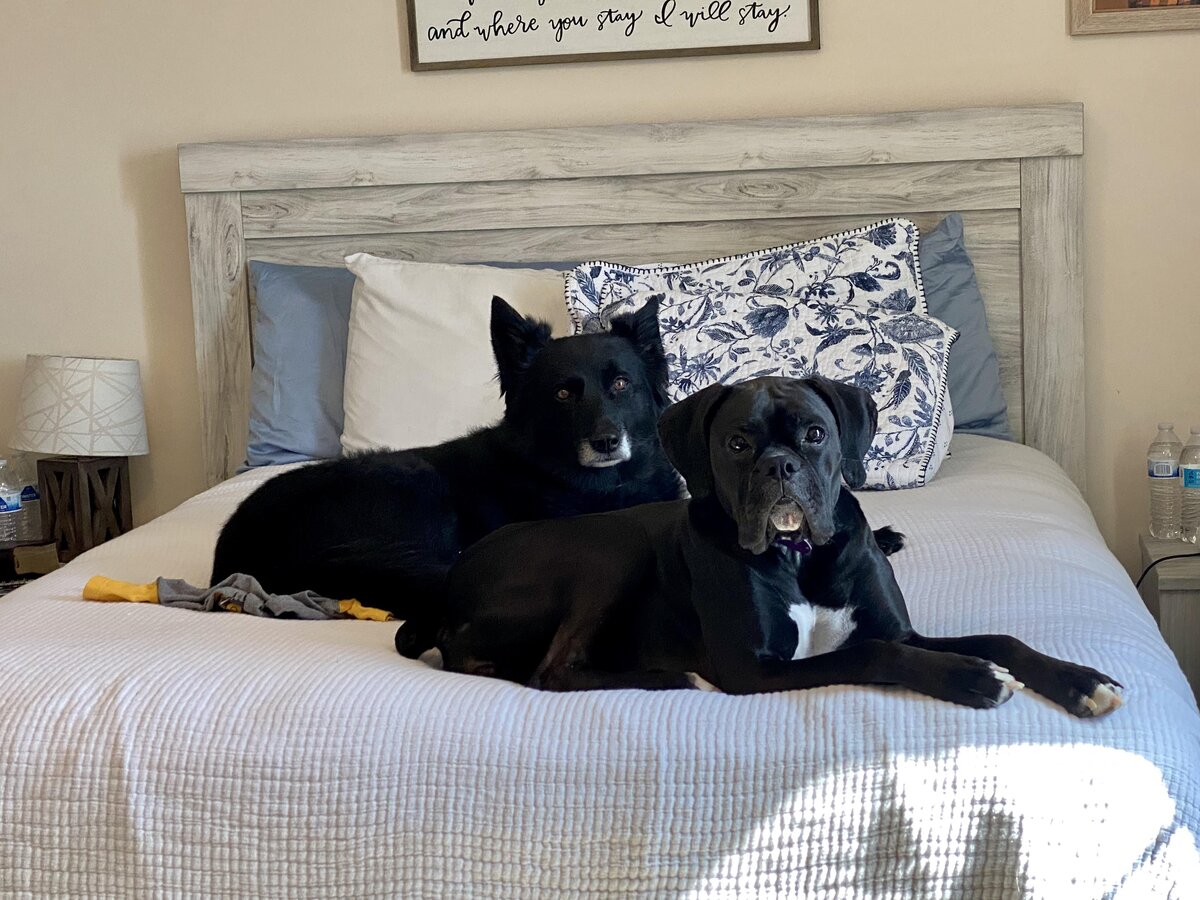
Being successful on Rover ultimately comes down to two things.
- Offering high-quality pet care services and receiving great reviews for them.
- Generating a basic understanding of how Rover’s algorithm chooses to show sitters.
To stand out, be as forthcoming with your profile as you possibly can be. Try to put yourself in the shoes of the pet owner. Take great photos of you and your space, pet care services in action, and highlight your experience and training.
While their algorithm is proprietary, my experience (and their own Rover 101 Guide) suggests that they use a weighted scoring model based on a number of factors when choosing which sitters appear at the top of search results.
To increase the likelihood of appearing near the top of the search results:
- Frequently assess your Availability.
- Respond to messages quickly.
- Focus on providing a 5-star experience to facilitate great testimonials.
- Maintain a low cancellation rate (and high booking rate).
- Have a high customer retention rate/repeat client rate.
- Thoroughly fill out your profile and services so that users who filter for specific conditions can find you.
In the broader business world, repeat business accounts for 66% of most companies’ earnings, and providing pet care services is no different. Your best clients will follow you for life. If welcome, send pictures and updates — a little reassurance goes a long way.
Treat them like family and they’ll come back time and again.
Related: How to Become a House Sitter and Find Paid House-Sitting Jobs
Rover.com Alternatives
While Rover is undoubtedly the nation’s largest pet care marketplace, it’s not the only one. If you’re having a hard time getting established, are merely looking to diversify income and find more clients, or your profile hasn’t been approved, you may have better luck with one of these alternatives to Rover.com.
Rover vs Wag
Wag typically offers higher earnings per walk but has fewer job opportunities compared to Rover. Rover provides a broader range of services like pet sitting and boarding, often leading to more consistent work availability, but at potentially lower rates per service.
Wag offers a unique perk in the form of its Wag! Premium, which includes 24/7 access to veterinary professionals and a $1M property damage protection plan, something not provided by Rover. Additionally, Wag has a more rigorous background check for its walkers, potentially offering greater peace of mind for pet owners. However, Rover excels with its Meet & Greet feature, allowing owners to meet sitters beforehand, a service not standardized in Wag’s offerings.
Rover vs. Fetch
Rover and Fetch Pet Care differ primarily in their operational model: Fetch operates through locally owned and operated franchises, providing more structured support and training to sitters. Fetch offers employees benefits like insurance and job support, which are not standard for Rover sitters who operate as independent contractors. Additionally, Fetch typically mandates uniform pricing and services across its locations, contrasting with Rover’s more diverse and customizable service options.
| |
|
|
|
|---|---|---|---|
| Pay | Varies (set by sitters) | Typically higher pay per walk | Uniform pricing set by franchises |
| Sitter Protections | Rover Guarantee, up to $25,000 in vet care reimbursements | Wag! Premium with 24/7 vet access, $1M damage protection | Employees with insurance and job support |
| Key Features | Offers a wide range of pet services including dog walking, pet sitting, and boarding | On-demand dog walking, rigorous vetting process | Operates through franchises, uniform services |
| Requirements | Background check, Rover must approve profile | Background check, rigorous vetting process | Background check, franchise-specific requirements |
| Provided Training | None, relies on the experience of sitters | None, relies on the experience of sitters | Training provided by franchises |
| Visit | Visit | Visit |
FAQs
The Bottom Line
Offering pet care services through Rover is one of many legitimate side hustle opportunities, especially if you have a special fondness for our furry friends. The flexibility to set your own schedule and rates allows sitters to partially determine their earnings ahead of time — especially if they have built up a list of personal connections and repeat customers.
That said, it is important not to discount the true task at hand: you are getting paid to take care of someone’s family member. Sitters have been sued by pet owners for negligent care beyond any protection that Rover can or will provide.
Providing a consistent professional experience for pet owners is the best way to generate recurring business, garner excellent testimonials, and boost future earning potential.
Related:
- 6 Cute Ways Dog Lovers Can Make Money with Their Canine Pals
- 13 Legit Apps That Pay You to Walk
- 50+ Legit Ways to Make Money Online from Home





